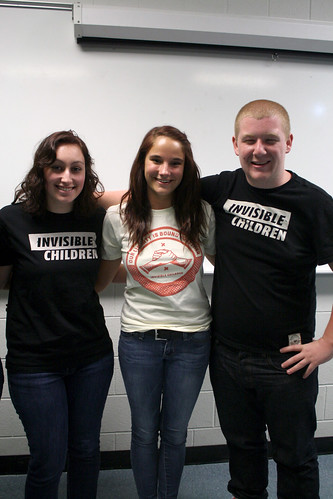
Invisible Children Inc.’s “Kony 2012” – the viral video reaching more than 83 million views on YouTube – is galvanizing America’s youth into making Joseph Kony, leader of the Lord’s Resistance Army, who abducts children for soldiers, infamous.
One of those young people is freshman geography and urban studies major Erika Firestone, who started donating to the cause after her eighth grade teacher showed her class Invisible Children’s first movie, “The Rough Cut.”
“I’ve always been really into Invisible Children, and when I came to school I joined [Temple Invisible Children] the first week I was here,” Firestone said.
Now, she’s vice president of Temple Invisible Children, a chapter of the national organization based in San Diego. The campus chapter raises awareness and funds for Invisible Children and Tree House Books in Philadelphia, Firestone said.
But with praise also came criticism directed at the Kony video and the Invisible Children organization, especially with regards to the organization’s finances.
According to its 2011 annual report, approximately 37.1 percent of IC’s expenses went toward Central African programs, approximately 26 percent went to awareness programs, and the rest towards management, awareness products, media and film creation and fundraising.
In Invisible Children’s financial statement for 2011, expenses for direct services were $2,810,681 and those for direct support were $146,603, which accounted for about 33 percent of the organization’s total spending.
Benjamin Talton, a professor of African history, said when examining Invisible Children’s finances, one should be wary of the “Inc.” at the end of its name, as opposed to an “Org.”
“Humanitarianism is a big business,” Talton said. “It’s big business in terms of revenues raised…and anytime you have these huge campaigns there’s always questions about where the money is going.”
Firestone said that while Invisible Children has successfully invested in African programs, like the Early Warning HF Radio Network, the organization is mostly focused on raising awareness, which means funding is needed for the organization’s movies, as well as for travel expenses for nation-wide talks with schools.
“The whole point is to let the government know that we as Americans care about what’s going on in another country,” Firestone said. “Because if [Uganda] looses support, the government is just going to take the soldiers out, and then we may never find [Kony].”
But it’s this idea, that the United States is the only body with the agency to solve Uganda’s problem, that Talton sees as “dangerous.”
“[The video] is making the United States out to be more than it is, as a force for moral good in the world,” Talton said. “It really distorts who we are as a nation, what we’re capable of doing. I mean, talk like this got us into Iraq, and that didn’t turn out so swimmingly, I think.”
Talton said the Kony video comes off as “a little patronizing” and “insulting,” because it doesn’t explain the “broader issues at play” with other African nations, and ignores Ugandan efforts to care and provide for ex-child soldiers.
To Talton, he said, it portrays a narrative of poor Africans needing the help of the West, one that he said has been common throughout the continent’s many plights.
However, Talton said the video brought some good by waking up millions of Americans to a cause that most of them were probably ignorant toward.
“I’m very impressed with how viral the video went,” Talton said. “We don’t all need to be running in the streets hanging up posters. If you can contribute that’s fine, but we have to be more responsible.”
Firestone said that students who cannot contribute money to Temple Invisible Children could still help raise awareness to the cause by attending meetings or participating in future events.
Temple Invisible Children is planning to host a screening of “Kony 2012” on March 29 at Gladfelter Hall at 7:30 p.m.
Payne Schroeder can be reached at payne.schroeder@temple.edu.



Be the first to comment